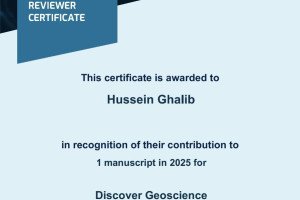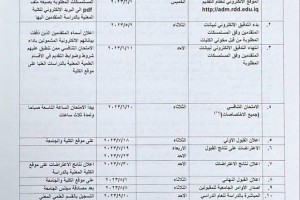
The College of Science at the University of Basrah organized a seminar entitled (Antimicrobial activity of nanoparticle synthesis of medicine plants) by thegraduate student Alaa Sadiq Hanish .The study aims To the use of Quercus infectoria extracts as antimicrobials and the synthesize of silver nanoparticles from these extracts to obtain materials with higher microbial activity and the current study include determined the most powerful alcoholic and aqueous extracts of some medicinal plants Quercus infectoria olivier, Urtica dioica L., Matricaria chamomilla L. ،Crataegus oxyacantha Thuill and Curcuma longa L. as antimicrobials and use for the synthesis of silver nanoparticles to determined their biological activityagainst pathogenic bacteria .The results showed that the aqueous and alcoholic extract of Q . infectoria was the most inhibited compared with other extracts , with highest inhibition zone 30 and.31 mm respectively of Proteus mirabilis , the percentage and qualitative tests of two extracts was determined and the phenolic and alkaloid compounds were extracted The active compounds of the extracts were identified by using GC-MS analysis, the results of GC-MS analysis showed identified 21 and 20 active compounds for both aqueous and alcoholic extracts tannin1,2,3-Benzenetriol recorded the highest .The (MIC) and (MBC) for tow extracts ,phenol and alkaloid compounds were determine the MIC of aqueous and alcoholic extract was 0.5 mg/ml towards S. aureus, P. Mirabilis and E. cloacae, while the MBC was1 mg/ml for the same isolates . towards P.aeruginosa, E. coli, B.cereus and K. pneumonia the MBC and MIC was 4 and 5 mg/ml, respectively. The results varied in MIC and MBC of phenolic compounds and alkaloids for different isolates. The aqueous extract used for synthesize of AgNPs which Detected by using UV spectroscopy the peak formation at the wavelength 450, FTIR and SEM scanning electron microscopy showed it was spherical in shape with sizes 61.54 and 41.82 nm .The efficacy of the manufacture AgNPs against pathogenic bacteria was also estimated using agar well-diffusion method the results of the biological activity of AgNPs showed a variance at different concentrations, and the activity increased by increasing the concentrations towards clinical bacterial isolates .The bioactivity of AgNPs ,silver salt , alcoholic and aqueous extract were also determined, showed that AgNPs have the beast effect as antimicrobial against clinical isolates, with inhibition zone of 25.66 mm towards P. Mirabilis and compared with chemical antibiotics and the study was recommended Possibility of conducting future studies on plant extracts of the Q. infectoria plant and AgNPs silver nanoparticles and combining them with antibiotics and studying their synergistic action .Conducting future studies of silver nanoparticles produced and applying them in other environmental, agricultural and medical fields .The use of extracts of the Q. infectoria plant in the production of other nanoparticles of different metals such as zinc, gold, copper and others .Improving the production of quantitatively and qualitatively produced silver nanoparticles by studying the effect of multiple factors such as temperature, pH, salt concentration, and others .Using silver nanoparticles produced as anti-fungals and anti-tumors.







